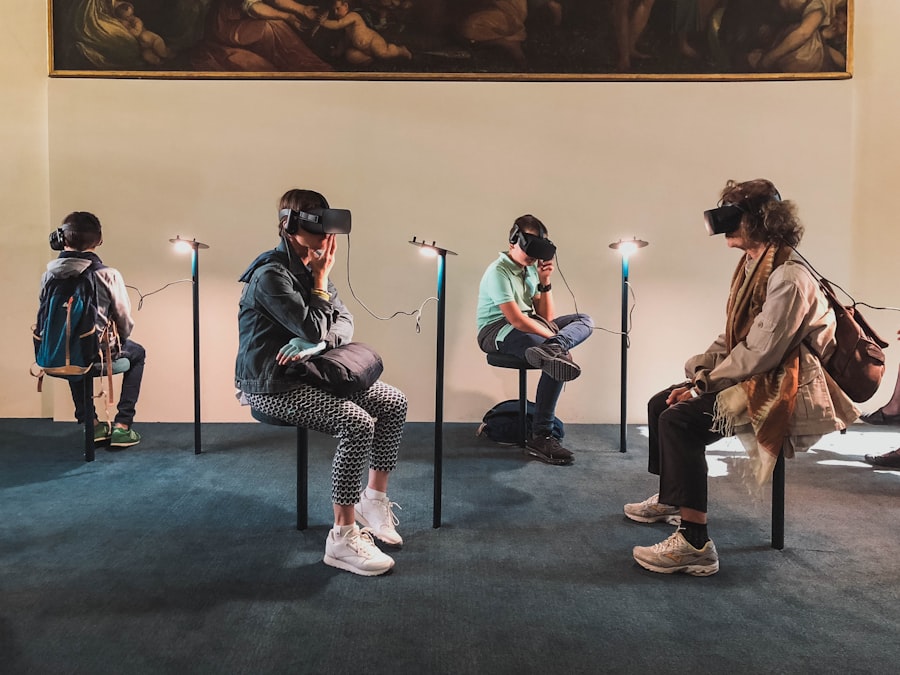Download links
How to install The Evolution of Electronic Games: From Pong to Virtual Reality APK?
1. Tap the downloaded The Evolution of Electronic Games: From Pong to Virtual Reality APK file.
2. Touch install.
3. Follow the steps on the screen.
Description
The inception of electronic games can be traced back to the early 1970s, a period marked by technological experimentation and innovation. One of the first commercially successful video games was “Pong,” released by Atari in 1972. This simple two-dimensional table tennis simulation captured the imagination of players with its straightforward mechanics and engaging gameplay.
Players controlled paddles on either side of the screen, bouncing a pixelated ball back and forth. The game’s success was monumental, leading to a surge in interest in video gaming and laying the groundwork for the burgeoning industry. Pong’s popularity demonstrated that electronic games could be more than just novelties; they could become a significant form of entertainment.
Atari’s success with Pong catalyzed the development of a variety of arcade games, leading to a golden age of arcade gaming in the late 1970s and early 1980s. Titles like “Space Invaders” and “Pac-Man” emerged, each contributing to the cultural zeitgeist of the time. Space Invaders, released in 1978, introduced a new level of strategy and competition, as players aimed to achieve high scores while fending off waves of descending aliens.
Pac-Man, launched in 1980, became an icon, transcending gaming to influence pop culture with its distinctive character and maze-chase gameplay. These games not only captivated players but also inspired a generation of developers who would go on to create more complex and engaging experiences.
Key Takeaways
- Electronic games have come a long way from the simple Pong to the revolutionary Atari, marking the birth of the gaming industry.
- The rise of home consoles like Nintendo, Sega, and PlayStation brought gaming into the living rooms of millions, changing the way people interacted with games.
- Mobile gaming has had a significant impact, from the classic Snake to the addictive Candy Crush, making gaming more accessible and convenient than ever before.
- The emergence of virtual reality with Oculus Rift and HTC Vive has opened up new possibilities for immersive gaming experiences.
- The future of gaming looks towards augmented reality and mixed reality, promising to blend the virtual and real worlds in exciting new ways.
- Esports has evolved from small LAN parties to massive international tournaments, becoming a global phenomenon with a dedicated fanbase and professional players.
The Rise of Home Consoles: Nintendo, Sega, and PlayStation
As arcade gaming flourished, the demand for home gaming systems began to rise. The late 1980s saw the emergence of home consoles that brought the arcade experience into living rooms across the globe. Nintendo’s NES (Nintendo Entertainment System), released in North America in 1985, played a pivotal role in this transition.
With its robust library of games, including classics like “Super Mario Bros.” and “The Legend of Zelda,” the NES revitalized the video game market after the crash of 1983. The console’s innovative design and user-friendly interface made it accessible to a broader audience, establishing Nintendo as a dominant force in the gaming industry. Sega soon entered the fray with its Sega Genesis, which debuted in North America in 1989.
The Genesis offered a more powerful hardware platform than its competitors, allowing for enhanced graphics and sound capabilities. Titles like “Sonic the Hedgehog” showcased this technological edge, introducing players to fast-paced gameplay and vibrant visuals. The rivalry between Nintendo and Sega ignited fierce competition that drove innovation and creativity within the industry.
Marketing campaigns like Sega’s “Genesis Does What Nintendon’t” highlighted the differences between the two companies, further fueling consumer interest and engagement. The arrival of Sony’s PlayStation in 1994 marked another significant turning point in home gaming. By leveraging CD-ROM technology, the PlayStation offered larger storage capacity for games compared to cartridges used by its predecessors.
This allowed developers to create more expansive worlds and intricate narratives. Titles such as “Final Fantasy VII” and “Metal Gear Solid” not only pushed the boundaries of storytelling in games but also established a new standard for cinematic experiences within interactive media. The PlayStation’s success solidified Sony’s position as a major player in the gaming industry, leading to a multi-faceted ecosystem that included sequels, spin-offs, and an ever-expanding library of titles.
The Impact of Mobile Gaming: From Snake to Candy Crush

The rise of app stores further democratized game distribution, allowing independent developers to reach audiences without traditional publishing barriers. Games like “Candy Crush Saga” exemplified this trend by combining simple mechanics with social features that encouraged competition among friends. Released in 2012, Candy Crush became a staple of mobile gaming culture, amassing billions of downloads and generating substantial revenue through microtransactions.
The Emergence of Virtual Reality: Oculus Rift and HTC Vive
| Metrics | Oculus Rift | HTC Vive |
|---|---|---|
| Release Date | March 28, 2016 | April 5, 2016 |
| Display Resolution | 2160 x 1200 | 2160 x 1200 |
| Field of View | 110 degrees | 110 degrees |
| Refresh Rate | 90 Hz | 90 Hz |
| Tracking Area | 5 x 11 feet | 15 x 15 feet |
Virtual reality (VR) emerged as a groundbreaking frontier in gaming technology, offering players an immersive experience that transcended traditional gameplay. The Oculus Rift, developed by Oculus VR and released to consumers in 2016, marked a significant milestone in making VR accessible to mainstream audiences. With its advanced head-tracking technology and high-resolution displays, the Rift allowed players to step into virtual worlds like never before.
Titles such as “Beat Saber” and “Half-Life: Alyx” showcased the potential of VR by combining engaging gameplay with immersive environments that made players feel as though they were truly part of the action. HTC Vive entered the market around the same time as Oculus Rift, further pushing the boundaries of what VR could achieve. With its room-scale tracking capabilities, Vive enabled players to move freely within their virtual environments, enhancing immersion through physical interaction.
Games like “Job Simulator” and “The Walking Dead: Saints & Sinners” utilized this technology to create experiences that required players to engage with their surroundings actively. The ability to physically duck, dodge, or reach out within a virtual space added layers of realism that traditional gaming could not replicate. Despite initial challenges related to cost and accessibility, VR has continued to evolve rapidly.
Advances in hardware have led to lighter headsets with improved graphics and reduced latency, while software development has expanded into various genres beyond gaming, including education, training simulations, and therapeutic applications. As VR technology becomes more refined and affordable, it holds the potential to redefine not only how games are played but also how stories are told within interactive media.
The Future of Gaming: Augmented Reality and Mixed Reality
As virtual reality continues to develop, augmented reality (AR) is emerging as another transformative force within the gaming landscape. Unlike VR, which immerses players in entirely virtual environments, AR overlays digital elements onto the real world, creating unique interactive experiences that blend both realms. One of the most notable examples is “Pokémon GO,” released in 2016 by Niantic Labs.
This mobile game utilized GPS technology to allow players to capture virtual Pokémon in real-world locations, encouraging exploration and social interaction among players. The success of Pokémon GO demonstrated AR’s potential to engage users in ways traditional gaming could not achieve. Players were not just interacting with their devices; they were also interacting with their surroundings and each other.
This social aspect became a defining feature of AR gaming, leading to events like community days where players gathered in parks or public spaces to catch rare Pokémon together. Such experiences highlighted how AR could foster community engagement while providing entertainment. Mixed reality (MR) takes this concept further by combining elements of both AR and VR to create interactive environments where digital objects can coexist with physical ones seamlessly.
Microsoft’s HoloLens exemplifies this technology by allowing users to interact with holographic images projected into their real-world environment. In gaming contexts, this could lead to experiences where players manipulate virtual objects while remaining aware of their physical surroundings. As developers explore MR’s possibilities, we may see innovative applications that enhance storytelling and gameplay mechanics in unprecedented ways.
The Evolution of Esports: From LAN Parties to International Tournaments

Esports has evolved from informal gatherings where friends competed against each other in local area networks (LAN) to a global phenomenon attracting millions of viewers and substantial sponsorship deals.
” These events fostered camaraderie among players while laying the groundwork for organized competitions. As internet connectivity improved and online multiplayer gaming became more prevalent, esports began to gain traction on a larger scale.
Tournaments such as Major League Gaming (MLG) emerged in the early 2000s, providing structured competitions for popular titles like “Halo” and “Call of Duty.” These events attracted dedicated fanbases and began streaming matches online through platforms like Twitch, which launched in 2011. This shift allowed fans worldwide to watch live competitions from their homes while interacting with other viewers through chat features. Today’s esports landscape is characterized by massive international tournaments featuring professional teams competing for multi-million dollar prize pools.
Events like The International for Dota 2 or the League of Legends World Championship draw millions of viewers both online and in-person at sold-out arenas worldwide. These tournaments have transformed competitive gaming into a legitimate career path for many players who train rigorously to hone their skills while attracting sponsorships from major brands seeking to tap into this lucrative market. The evolution of esports has also led to increased recognition from traditional sports organizations and media outlets.
Universities now offer scholarships for aspiring esports athletes, while professional leagues are being established for various titles akin to traditional sports leagues. As esports continues to grow in popularity and legitimacy, it is poised to become an integral part of global entertainment culture for years to come.
If you’re a fan of electronic games, you might also be interested in trying your luck with Taya365 Lottery. With the chance to win big prizes, this online lottery platform offers an exciting opportunity for gamers and enthusiasts alike. Check out this article to learn more about how you can potentially score a major win with Taya365 Lottery.
FAQs
What are electronic games?
Electronic games are games that are played using electronic devices such as computers, gaming consoles, or mobile devices. These games can range from simple puzzle games to complex multiplayer online games.
What are the different types of electronic games?
There are various types of electronic games, including action games, adventure games, role-playing games, simulation games, strategy games, sports games, and puzzle games. Additionally, there are also educational games and games designed for fitness and exercise.
What are the benefits of playing electronic games?
Playing electronic games can have several benefits, including improving cognitive skills, problem-solving abilities, hand-eye coordination, and strategic thinking. Additionally, some games are designed to be educational and can help with learning and development.
Are there any potential drawbacks to playing electronic games?
Excessive gaming can lead to negative effects such as addiction, social isolation, and decreased physical activity. It is important to balance gaming with other activities and to be mindful of the amount of time spent playing electronic games.
What are some popular electronic games?
Some popular electronic games include “Fortnite,” “Minecraft,” “Call of Duty,” “League of Legends,” “FIFA,” “The Legend of Zelda,” “Super Mario,” and “Candy Crush Saga.” These games span various genres and platforms, catering to a wide range of players.





